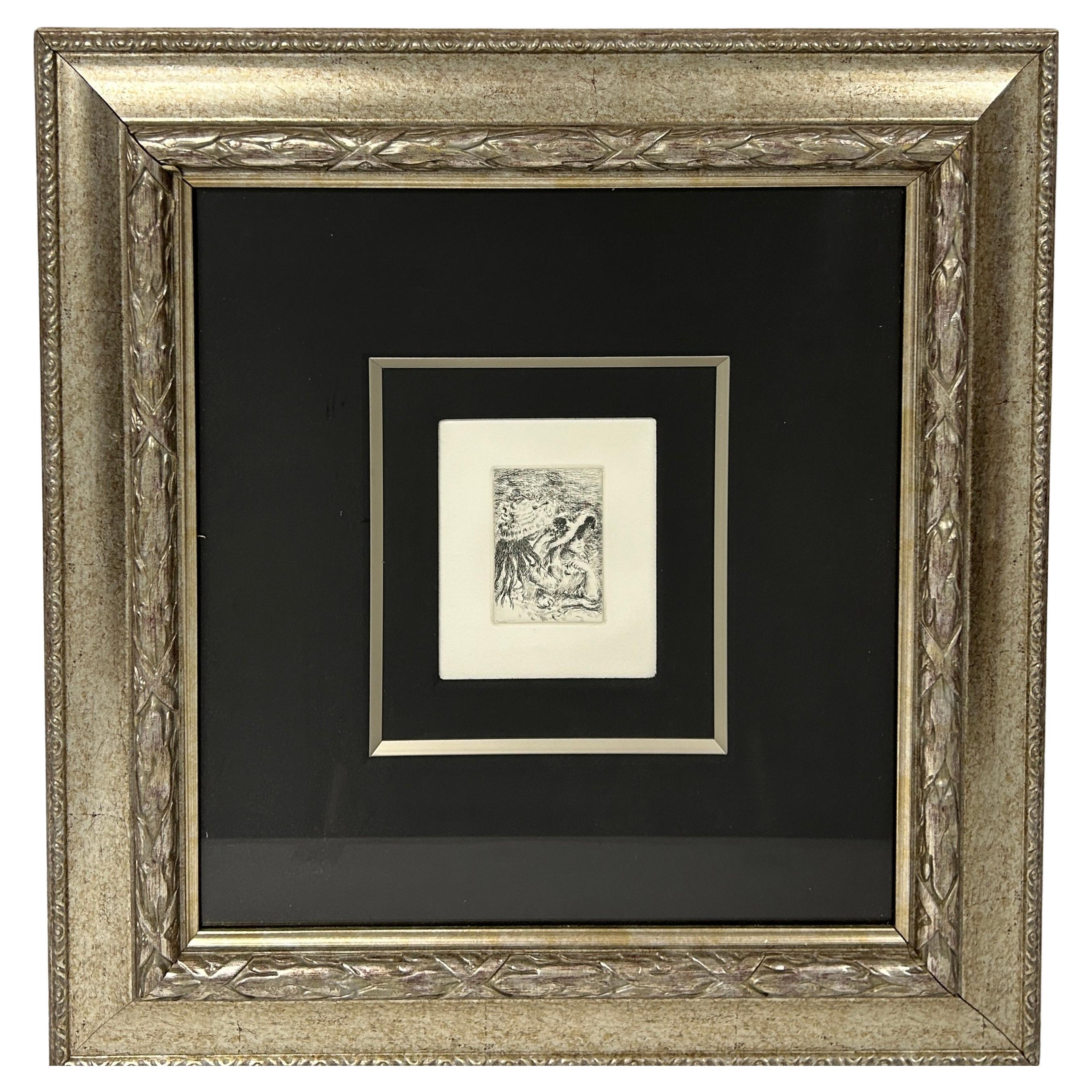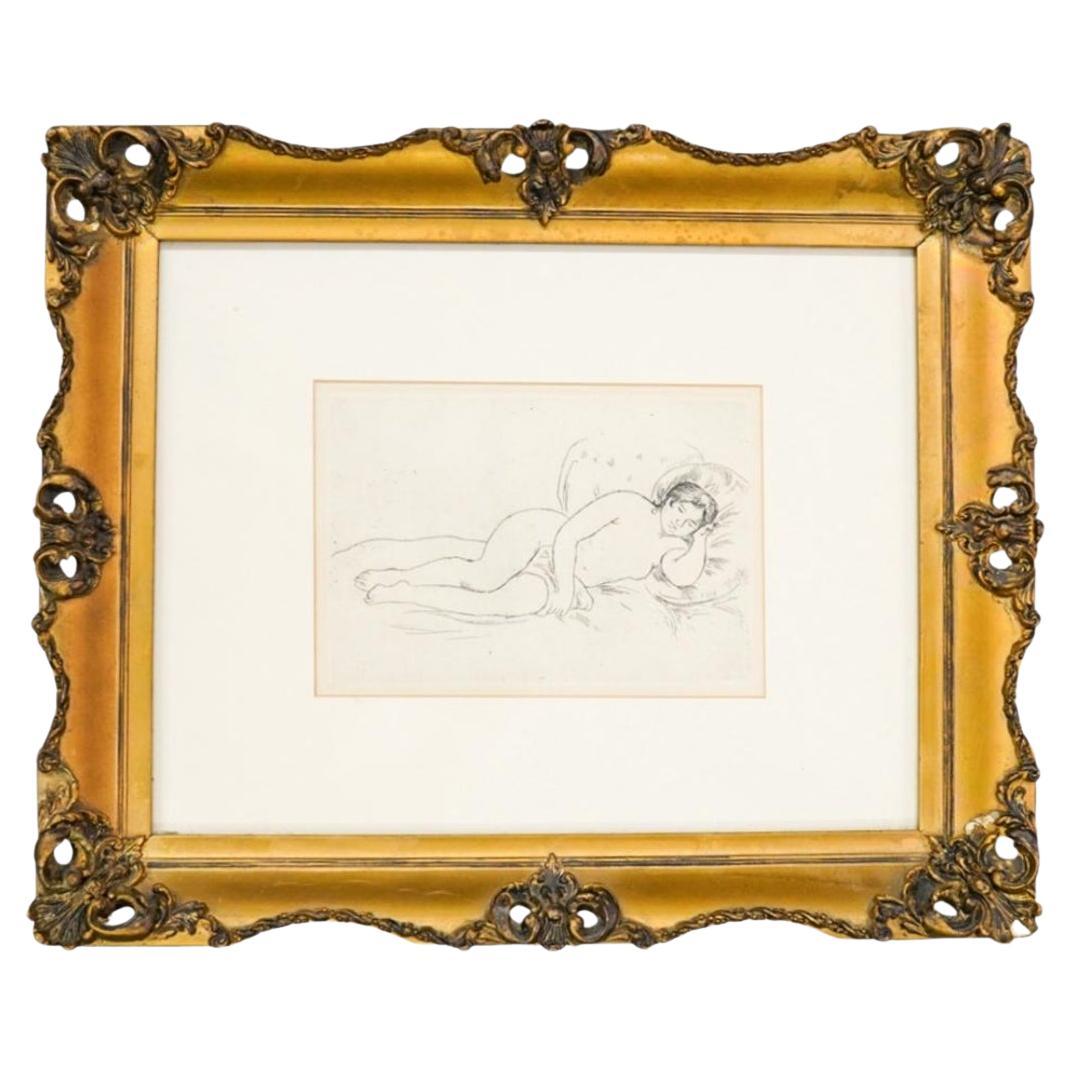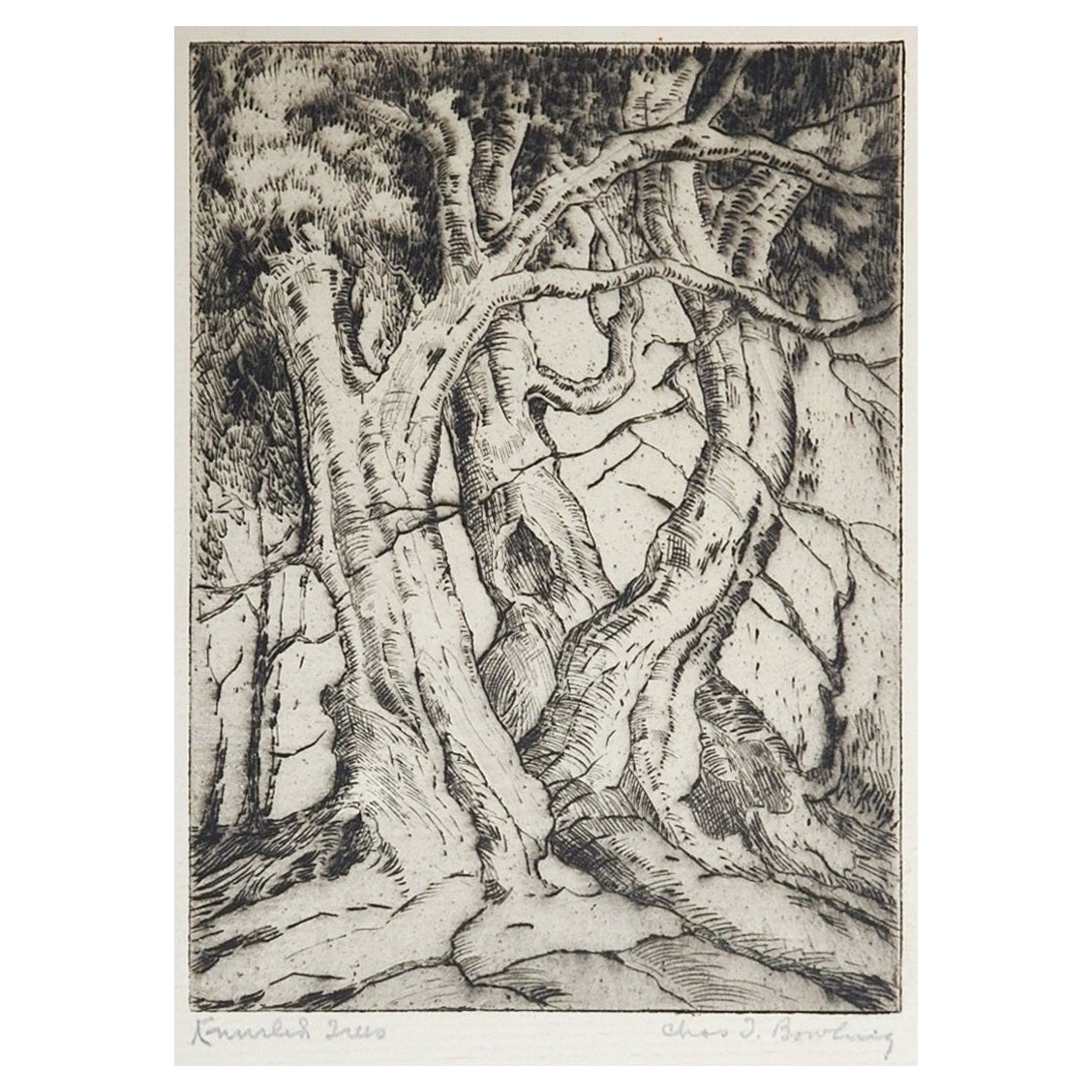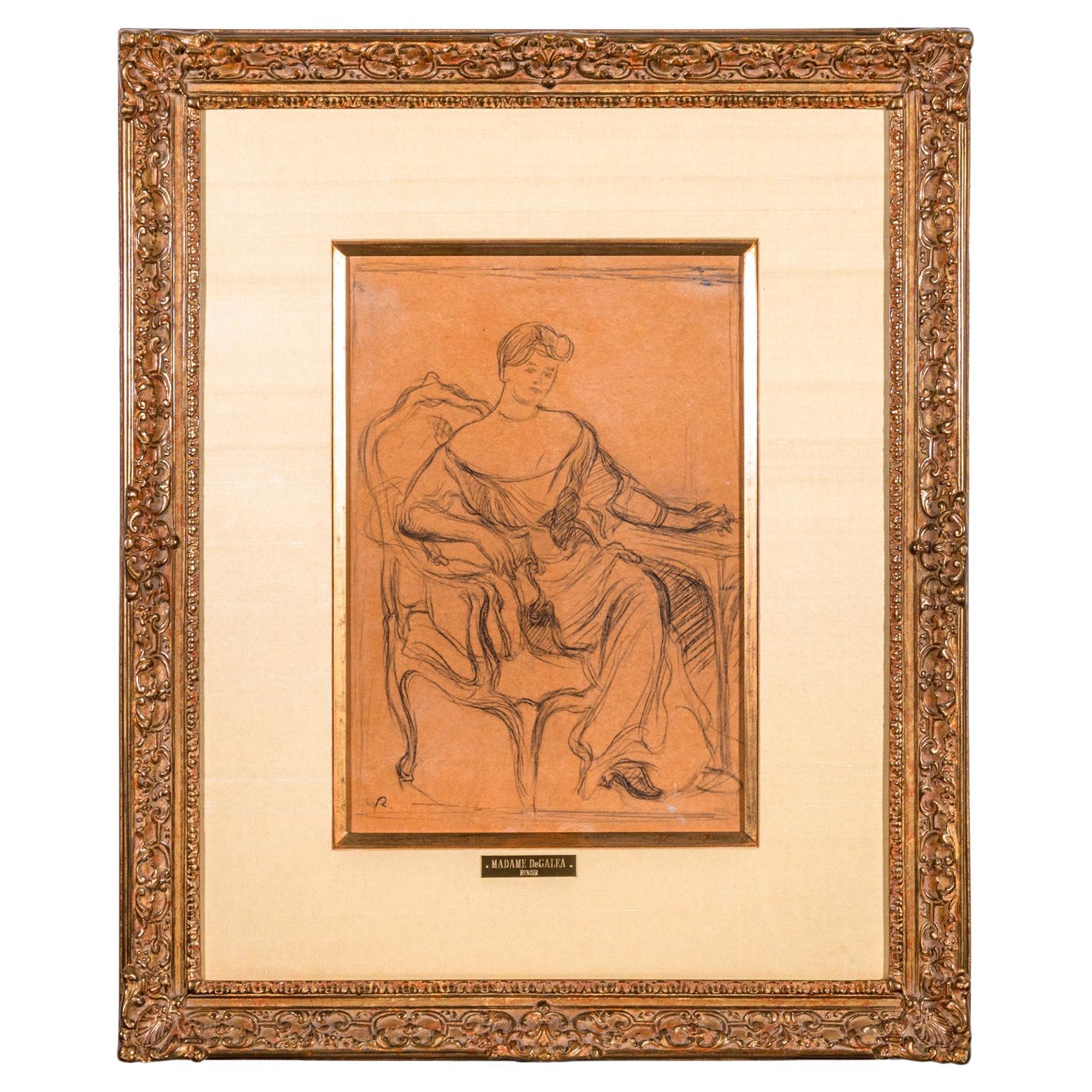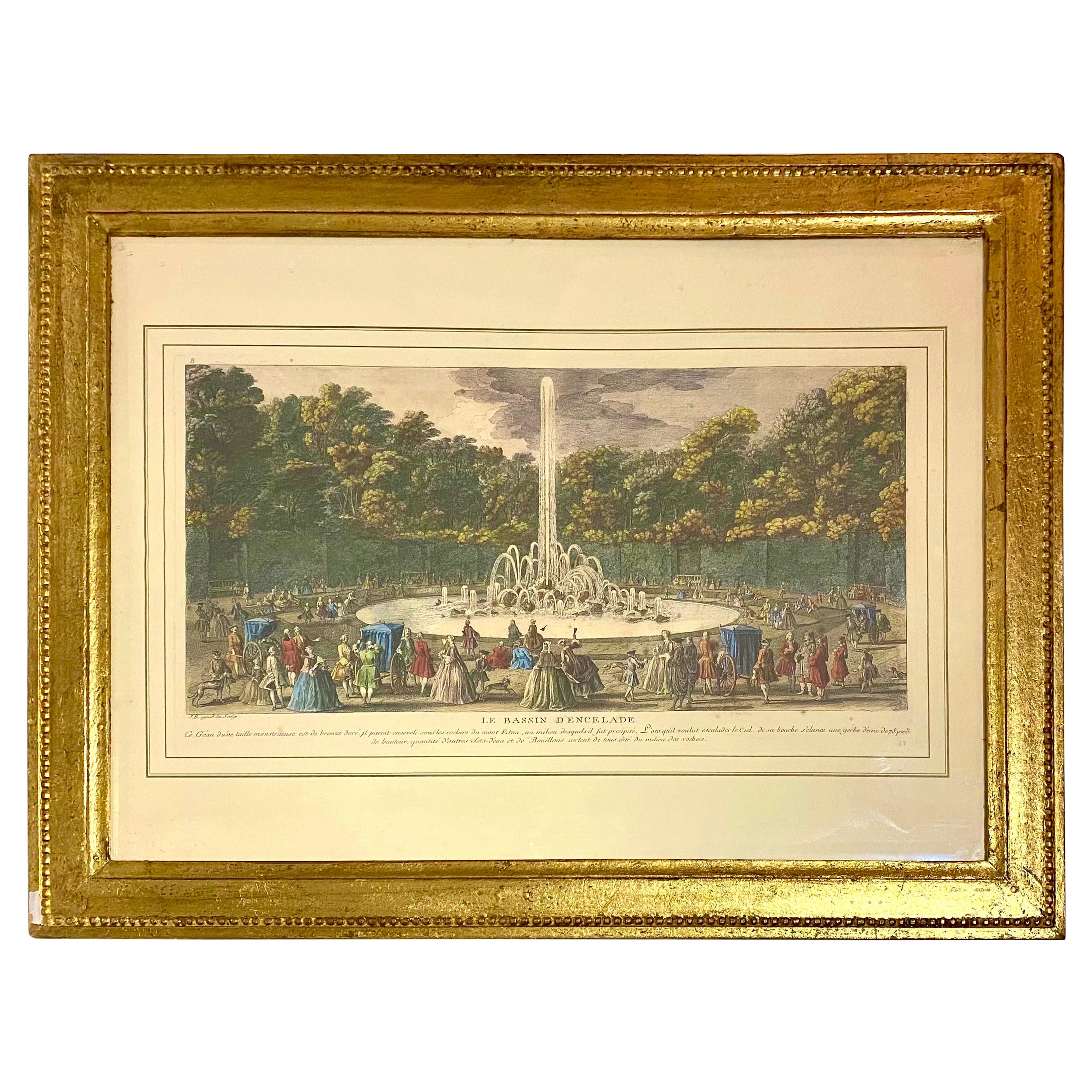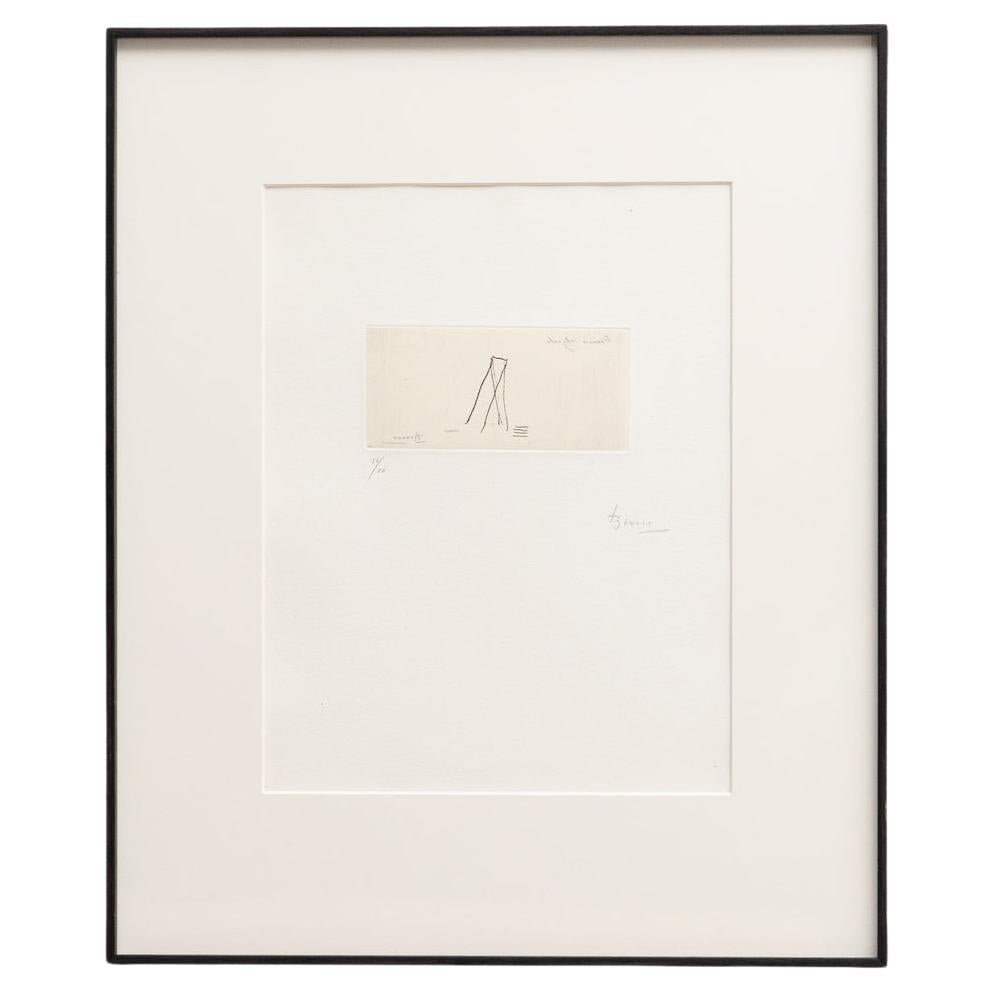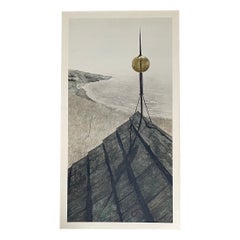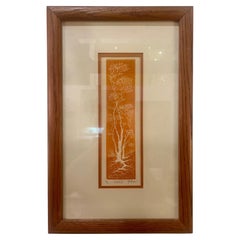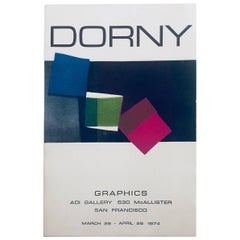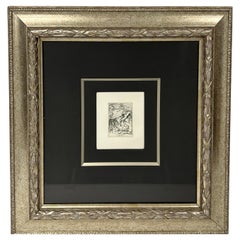
"Le Chapeau Epingle" by Pierre Auguste Renoir Framed Dry Point Etching, 1894
View Similar Items
"Le Chapeau Epingle" by Pierre Auguste Renoir Framed Dry Point Etching, 1894
About the Item
- Creator:Pierre-Auguste Renoir (Artist)
- Dimensions:Height: 19 in (48.26 cm)Width: 15 in (38.1 cm)Depth: 0.75 in (1.91 cm)
- Style:Expressionist (In the Style Of)
- Materials and Techniques:Paper,Etched
- Place of Origin:
- Period:
- Date of Manufacture:1894
- Condition:Wear consistent with age and use.
- Seller Location:San Diego, CA
- Reference Number:1stDibs: LU936616752421
Pierre-Auguste Renoir
Pierre-Auguste Renoir began his artistic career as a porcelain painter but began copying paintings at the Louvre in 1860 and eventually entered the studio of Charles Gleyre, where he met Claude Monet, Frédéric Bazille, and Alfred Sisley. The four friends began painting in the forest of Fontainebleau, although Renoir always remained dedicated to figure painting and portraits influenced by Gustave Courbet.
In the summer of 1869, Renoir painted for two months alongside Monet at La Grenouillère outside Paris. After several of his paintings were rejected by the Salon in the early 1870s, he decided to join Monet in establishing the Impressionists, who sought to capture modern life including everyday people, streets, and surroundings.
Renoir's penchant for portraiture attracted the attention of a range of patrons with avant-garde sensibilities and sustained him financially. His doubts about the spontaneity and impermanence of the Impressionist aesthetic led him to refuse to participate in the fourth Impressionist exhibition in 1878. Instead, he decided to look back to the Old Masters, leaving for Italy in 1881 to continue his self-education in the “grandeur and simplicity of the ancient painters.” He returned enamored of Raphael and Pompeii and his figures consequently became more crisply drawn and sculptural in character.
By the late 1880s and early 1890s, Renoir had shifted his investigation of the Old Masters from linear classicism to the colouristic traditions of Titian and Rubens as well as the unabashedly sensual beauty of eighteenth-century French art such as the nudes of Rubens and Fragonard. Renoir's most important series of the decade came from an invitation by the French government to execute a painting for the Musée du Luxembourg, a new museum devoted to the work of living artists. Renoir made five versions of Two Young Girls at the Piano for the Minister of Fine Arts to choose from; the version in the Robert Lehman Collection at the Metropolitan Museum of Art is one of the finest. The subject of Two Young Girls at the Piano recalls eighteenth-century French genre scenes, especially those of Fragonard.
In the early twentieth century, despite old age and declining health, Renoir persisted in artistic experimentation. He took up sculpture and continued to paint portraits attesting to his continued admiration of Renaissance art. Renoir was also drawn to an arcadian ideal of Mediterranean classicism in his art. This artistic preoccupation is nowhere more apparent than in his twentieth-century bathers. The Rubenesque nudes he had been painting reached a level of unprecedented exaggeration in the twentieth century, culminating in the massive Bathers at the Musée d'Orsay.
Find original Pierre-Auguste Renoir prints, paintings and other art on 1stDibs.
(Biography provided by Stern Pissarro Gallery)
- "Nothern Point" Color Collotype Print by Andrew WyethBy Andrew WyethLocated in San Diego, CA"Nothern Point" signed in print color collotype print by Andrew Wyeth, circa 1950s. The piece is in very good vintage condition and comes unframed mounted on board. This wonderful pi...Category
20th Century American Prints
MaterialsWood
- Al Kaufman Framed Original Signed & Numbered Etching with COA 75/300Located in San Diego, CAOriginal 1970's etching by Listed artist Al Kaufman , framed in glass and oak with COA signed an numbered Sandalwood title.Category
20th Century American American Classical Prints
MaterialsGlass, Oak, Paper
- "Dorny" Aqua Tint Etching by Bertrand DornyBy Bertrand DornyLocated in San Diego, CAUntitled aqua tint etching by French artist Bertrand Dorny. Dorny was a well-known painter before turning to graphic art. Textural qualities due to the paper used and the pressure ap...Category
Vintage 1970s Unknown Posters
MaterialsPaper
$600 Sale Price20% Off - Rare Framed Framed Lithograph by Georges Braque for Galerie MaeghtBy Georges BraqueLocated in San Diego, CAA very rare nicely framed original lithograph by Georges Braque for Galerie Maeght, circa 1950s.Category
20th Century French Mid-Century Modern Prints
MaterialsGlass
- Hand Signed Limited Edition Lithograph "Lagune" by Pierre DoutreleauLocated in San Diego, CAHand signed limited edition lithograph entitled "Lagune" by listed French artist Pierre Doutreleau, circa 1985. The print is in very good vintage con...Category
Late 20th Century French Post-Modern Prints
MaterialsPaper
- Images of Children Etching Entitled "Sleeping Mother" by Will BarnetBy Will BarnetLocated in San Diego, CALimited edition "Images of Children" etching entitled "Sleeping Mother" by Will Barnet, circa 1982. This a second printing of a suite of 8 woodcuts and etchings created from 1937 to 1940; the print has the chop of the printer, Stephen Sholinsky...Category
20th Century American Prints
MaterialsPaper
- Limited Edition Renoir Lithograph, "Le Chapeau Epingle" (Pinning the Hat)By Pierre-Auguste RenoirLocated in Bradenton, FLAuguste Renoir etching, Le Chapeau Epingle "Pinning the Hat", third version from the original 1894 etching. This is an etching of the artist Manet's niece and her cousin adjusting th...Category
Early 20th Century French Expressionist Drawings
MaterialsGlass, Wood, Paper
- Pierre-Auguste Renoir "Femme Nue Couchee" Etching, FramedBy Pierre-Auguste RenoirLocated in Waxahachie, TXPierre Auguste Renoir 1841-1919 Historical Description This lovely image captures a sense of innocence and repose. With his delicate use of line, Renoir conveys a sense of grace an...Category
Antique Early 1900s French Beaux Arts Drawings
MaterialsPaper
- Vintage 1930s Charles Bowling Knurled Trees Dry Point EtchingLocated in Seguin, TXVintage circa 1930's dry point etching on paper by Charles T. Bowling (1891 - 1985) Texas. He was active in the pre-World War II group of Regionalist artist...Category
Vintage 1930s American Arts and Crafts Prints
MaterialsPaper
- James Jacques Joseph Tissot "Soirée d'été" 'Summer Evening' Etching & Dry PointBy James TissotLocated in Los Angeles, CAA fine French 19th century etching and drypoint Titled "Soirée d'été" (Summer Evening) by Jacques Joseph Tissot (French, 1836-1902) depicting Mrs. Kathleen Newton resting on a lounge chair. Signed and dated (l/l): J.J. Tissot, 1881 in the plate. Under the mat, the front of the sheet inscribed in pencil with a '1' in a circle, the verso of the sheet with old price inscription "450-" in pencil. Circa: 1881-1882. Measures: Plate Height: 9 inches (22.9 cm) Plate Width: 15 1/2 inches (39.4 cm) Sheet Height: 14 1/2 inches (36.8 cm) Sheet Width: 20 5/8 inches (52.4 cm) Frame Height: 19 inches (48.3 cm) Frame Width: 24 1/2 inches (62.2 cm) Frame Depth: 1 1/8 inches (2.9 cm) Literature: Wentworth 56. Note: Tissot's from 1881 is said to depict his lover, the Irish divorcee Mrs. Kathleen Newton, resting on a lounge chair. Provenance: Private collection, Los Angeles, California Jacques Joseph Tissot (French, 15 October 1836 – 8 August 1902), Anglicized as James Tissot, was a French painter and illustrator. He was a successful painter of Paris society before moving to London in 1871. He became famous as a genre painter of fashionably dressed women shown in various scenes of everyday life. He also painted scenes and characters from the Bible. Jacques Tissot was born in the city of Nantes in France and spent his early childhood there. His father, Marcel Théodore Tissot, was a successful drapery merchant. His mother, Marie Durand, assisted her husband in the family business and designed hats. A devout Catholic, Tissot's mother instilled pious devotion in the future artist from a very young age. Tissot's youth spent in Nantes likely contributed to his frequent depiction of shipping vessels and boats in his later works. The involvement of his parents in the fashion industry is believed to have been an influence on his painting style, as he depicted women's clothing in fine detail. By the time Tissot was 17, he knew he wanted to pursue painting as a career. His father opposed this, preferring his son to follow a business profession, but the young Tissot gained his mother's support for his chosen vocation. Around this time, he began using the given name of James. By 1854 he was commonly known as James Tissot; he may have adopted it because of his increasing interest in everything English. In 1856 or 1857, Tissot travelled to Paris to pursue an education in art. While staying with a friend of his mother, painter Elie Delaunay, Tissot enrolled at the Ecole des Beaux-Arts to study in the studios of Hippolyte Flandrin and Louis Lamothe. Both were successful Lyonnaise painters who moved to Paris to study under Jean-Auguste-Dominique Ingres. Lamothe provided the majority of Tissot's studio education, and the young artist studied on his own by copying works at the Louvre, as did most other artists of the time in their early years. Around this time, Tissot also made the acquaintance of the American James McNeill Whistler, and French painters Edgar Degas (who had also been a student of Lamothe and a friend of Delaunay), and Édouard Manet. In 1859, Tissot exhibited in the Paris Salon for the first time. He showed five paintings of scenes from the Middle Ages, many depicting scenes from Goethe's Faust. These works show the influence in his work of the Belgian painter Henri Leys (Jan August Hendrik Leys), whom Tissot had met in Antwerp earlier that same year. Other influences include the works of the German painters Peter Von Cornelius and Moritz Retzsch. After Tissot had first exhibited at the Salon and before he had been awarded a medal, the French government paid 5,000 francs for his depiction of The Meeting of Faust and Marguerite in 1860, with the painting being exhibited at the Salon the following year, together with a portrait and other paintings. Émile Péreire supplied Tissot's painting Walk in the Snow for the 1862 international exhibition in London; the next year three paintings by Tissot were displayed at the London gallery of Ernest Gambart. In about 1863, Tissot suddenly shifted his focus from the medieval style to the depiction of modern life through portraits. During this period, Tissot gained high critical acclaim, and quickly became a success as an artist. Like contemporaries such as Alfred Stevens and Claude Monet, Tissot also explored Japonisme, including Japanese objects and costumes in his pictures and expressing style influence. Degas painted a portrait of Tissot from these years (Metropolitan Museum of Art, New York), in which he is sitting below a Japanese screen hanging on the wall. Still on Top, 1873 Tissot fought in the Franco-Prussian War as part of the improvised defense of Paris, joining two companies of the Garde Nationale and later as part of the Paris Commune. His 1870 painting La Partie Carrée (The Foursome) evoked the period of the French revolution. Either because of the radical political associations related to the Paris Commune (which he was believed to have joined mostly to protect his own belongings rather than for shared ideology), or because of better opportunities, he left Paris for London in 1871. During this period, Seymour Haden helped him to learn etching techniques. Having already worked as a caricaturist for Thomas Gibson Bowles, the owner of the magazine Vanity Fair, as well as exhibited at the Royal Academy, Tissot arrived with established social and artistic connections in London. Tissot used...Category
Antique Late 19th Century French Victorian Drawings
MaterialsGlass, Wood, Paper
$4,850 Sale Price24% Off - Pierre-Auguste Renoir Madame de Galéa Signed Original Sketch Graphite on PaperBy Pierre-Auguste RenoirLocated in Keego Harbor, MIA lovely impressionist portrait graphite drawing on paper titled “Madame de Galéa” by Pierre-Auguste Renoir. Hand signed “R” on the bottom left. Created circa 1900s. On the verso it ...Category
Antique Early 1900s Drawings
MaterialsPaper
- Dance in the City Oil Painting on Canvas After Pierre Auguste Renoir 46"By Pierre-Auguste RenoirLocated in Dayton, OHVintage oil painting on canvas after Pierre Auguste Renoir, titled Dance in the City. Dance in the City is a painting created by the French artist Pierre-Auguste Renoir. Completed ...Category
Late 20th Century Paintings
MaterialsCanvas, Paint
